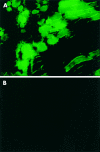Attenuated acute liver injury in mice by naked hepatocyte growth factor gene transfer into skeletal muscle with electroporation
- PMID: 11889079
- PMCID: PMC1773169
- DOI: 10.1136/gut.50.4.558
Attenuated acute liver injury in mice by naked hepatocyte growth factor gene transfer into skeletal muscle with electroporation
Abstract
Background: Hepatocyte growth factor (HGF) plays an essential role in hepatic development and regeneration, and shows proliferative and antiapoptotic activity in hepatocytes.
Aims: To establish an effective new method for HGF gene transfer in vivo and to investigate its effects in acute experimental liver injury.
Animals: Eight week old female mice were used.
Methods: Rat HGF gene in a modified pKSCX plasmid was transferred to the tibialis anterior muscle by electroporation using a pulse generator. Four days later, plasma HGF concentrations were determined by enzyme linked immunosorbent assay every two days for three weeks. To confirm the efficacy of electroporation, a plasmid bearing green fluorescence protein (GFP) was transferred similarly. Four days after electroporation, carbon tetrachloride (CCl(4)) was administered to mice to induce acute liver injury. Plasma alanine aminotransferase (ALT) activity was measured. Hepatic apoptosis was assessed by Hoechst 33258 staining and the TUNEL method.
Results: Fluorescence microscopy showed strong green fluorescence where the GFP gene had been transferred into muscle. In mice given the HGF gene, HGF in plasma was increased up to fourfold from pretreatment amounts, peaking 6-9 days after electroporation and quickly decreasing within three weeks. Compared with the group without HGF transfer, the percentage of apoptotic hepatocytes after CCl(4) intoxication was significantly lower, as was ALT activity. In addition, ALT activity normalised more rapidly in the HGF gene transfer group.
Conclusions: Naked DNA injection and transfer by electroporation efficiently brings about HGF expression in vivo, which can attenuate acute liver injury.
Figures







Similar articles
-
Hepatocyte growth factor gene therapy accelerates regeneration in cirrhotic mouse livers after hepatectomy.Gut. 2003 May;52(5):694-700. doi: 10.1136/gut.52.5.694. Gut. 2003. PMID: 12692055 Free PMC article.
-
Metron factor-1 prevents liver injury without promoting tumor growth and metastasis.Hepatology. 2008 Jun;47(6):2010-25. doi: 10.1002/hep.22243. Hepatology. 2008. PMID: 18506889
-
Hepatocyte growth factor gene transfer into the liver via the portal vein using electroporation attenuates rat liver cirrhosis.Gene Ther. 2003 Sep;10(18):1559-66. doi: 10.1038/sj.gt.3302052. Gene Ther. 2003. PMID: 12907947
-
A Critical Review of Electroporation as A Plasmid Delivery System in Mouse Skeletal Muscle.Int J Mol Sci. 2019 Jun 6;20(11):2776. doi: 10.3390/ijms20112776. Int J Mol Sci. 2019. PMID: 31174257 Free PMC article. Review.
-
Plasmid DNA gene therapy by electroporation: principles and recent advances.Curr Gene Ther. 2011 Dec;11(6):447-56. doi: 10.2174/156652311798192860. Curr Gene Ther. 2011. PMID: 22023474 Review.
Cited by
-
A synthetic biology-based device prevents liver injury in mice.J Hepatol. 2016 Jul;65(1):84-94. doi: 10.1016/j.jhep.2016.03.020. Epub 2016 Apr 9. J Hepatol. 2016. PMID: 27067456 Free PMC article.
-
Using reconfigurable microfluidics to study the role of HGF in autocrine and paracrine signaling of hepatocytes.Integr Biol (Camb). 2015 Jul;7(7):815-24. doi: 10.1039/c5ib00105f. Integr Biol (Camb). 2015. PMID: 26108037 Free PMC article.
-
Skeletal muscle targeting in vivo electroporation-mediated HGF gene therapy of bleomycin-induced pulmonary fibrosis in mice.Lab Invest. 2004 Jul;84(7):836-44. doi: 10.1038/labinvest.3700098. Lab Invest. 2004. PMID: 15197407 Free PMC article.
-
Hepatocyte growth factor gene therapy accelerates regeneration in cirrhotic mouse livers after hepatectomy.Gut. 2003 May;52(5):694-700. doi: 10.1136/gut.52.5.694. Gut. 2003. PMID: 12692055 Free PMC article.
-
Autocrine expression of hepatocyte growth factor and its cytoprotective effect on hepatocyte poisoning.World J Gastroenterol. 2004 Oct 1;10(19):2827-30. doi: 10.3748/wjg.v10.i19.2827. World J Gastroenterol. 2004. PMID: 15334679 Free PMC article.
References
-
- Nakamura T, Nawa K, Ichihara A, et al. Purification and subunit structure of hepatocyte growth factor from rat platelets. FEBS Lett 1987;224:311–16. - PubMed
-
- Matsumoto K, Nakamura T. Hepatocyte growth factor: Molecular structure, roles in liver regeneration, and other biological functions. Crit Rev Oncog 1992;3:27–54. - PubMed
-
- Boros P, Miller CM. Hepatocyte growth factor: a multifunctional cytokine. Lancet 1995;345:293–5. - PubMed
-
- Ricci G, Catizone A, Innocenzi A, et al. Hepatocyte growth factor (HGF) receptor expression and role of HGF during embryonic mouse testis development. Dev Biol 1999;216:340–7. - PubMed
MeSH terms
Substances
LinkOut - more resources
Full Text Sources
Other Literature Sources
Medical
